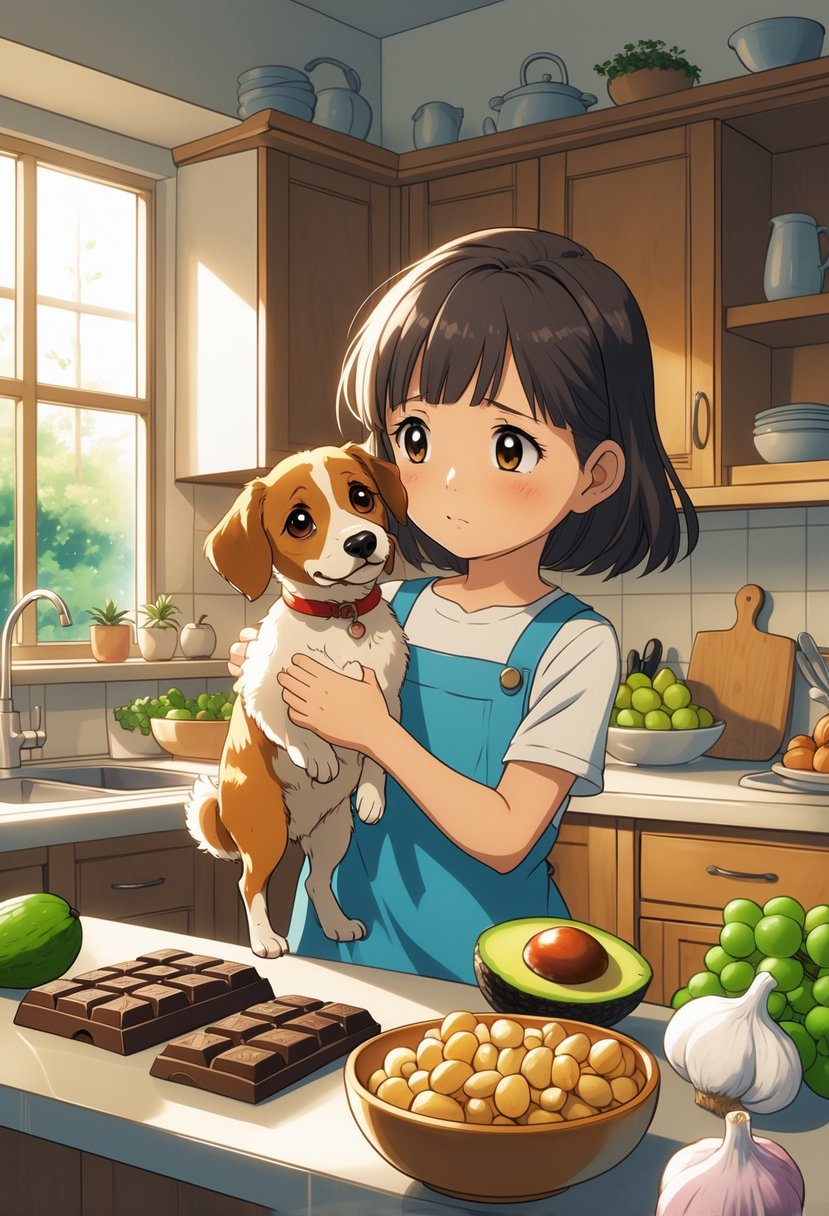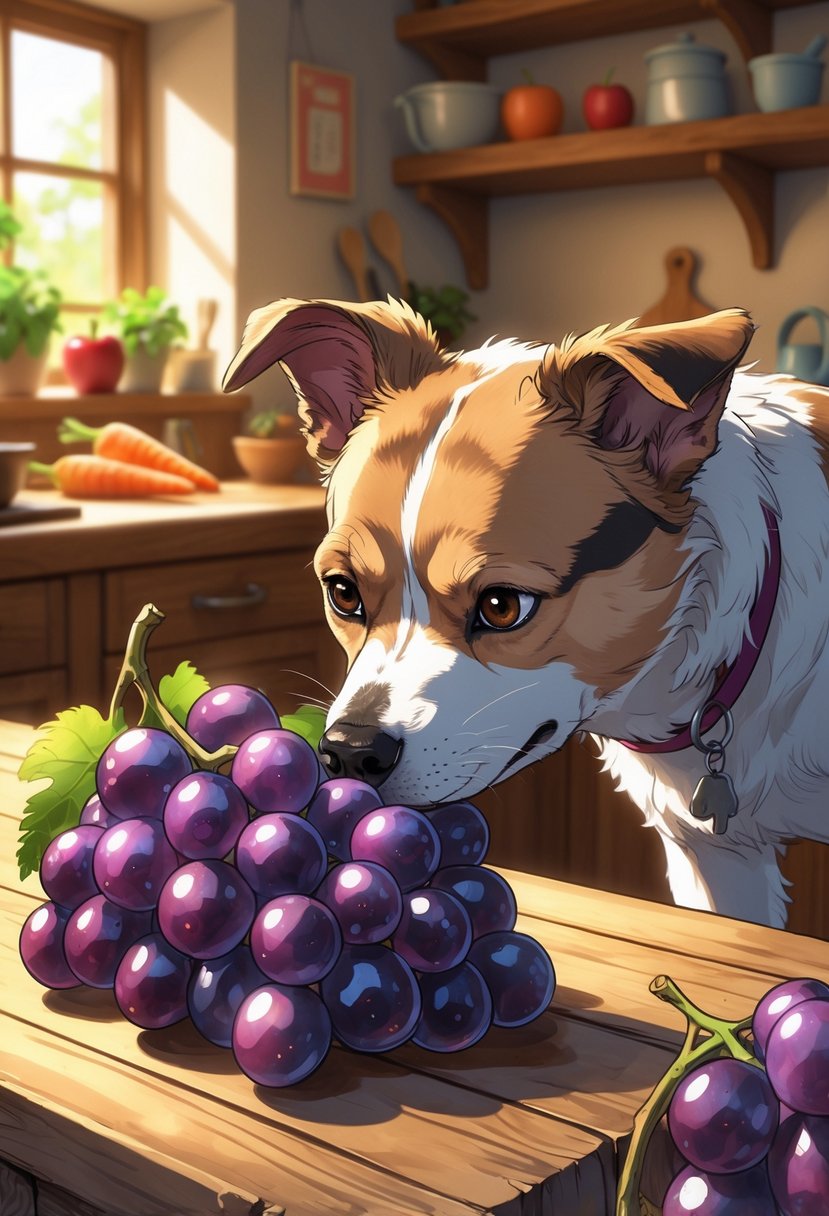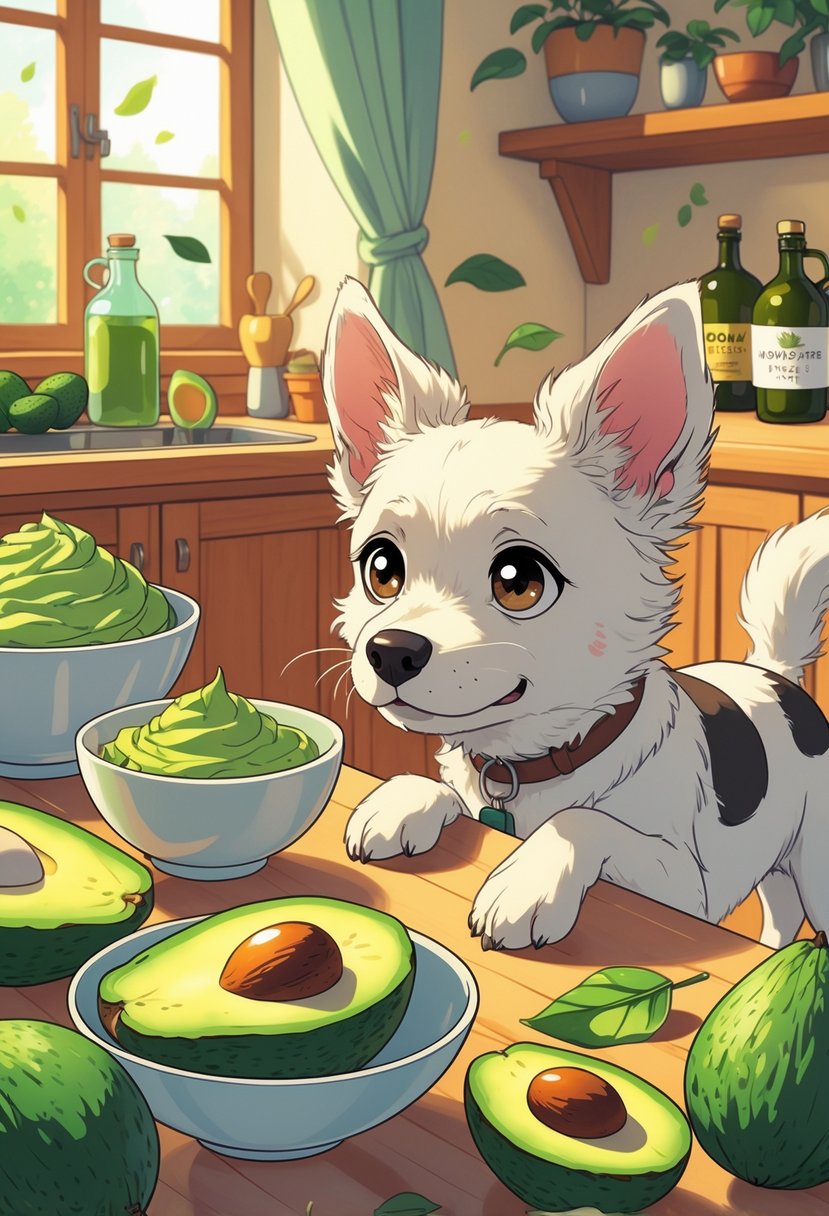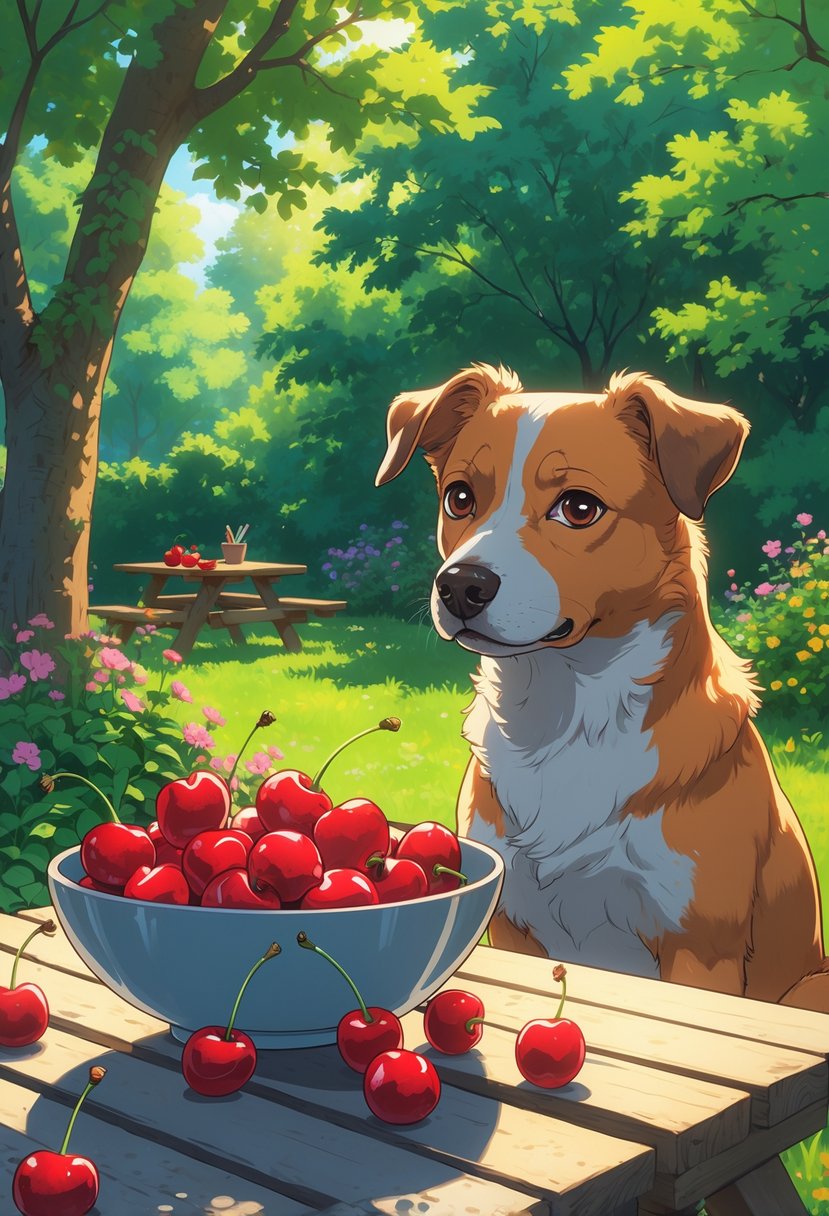Sharing food with your dog might feel harmless, but some everyday items can cause serious health problems. Many common foods like chocolate, grapes, onions, garlic, and xylitol are toxic to dogs and can lead to dangerous conditions such as kidney failure, anemia, or even death. Knowing which foods to avoid is one of the most important steps you can take to protect your dog’s health.

You may not realize how quickly a small bite of the wrong food can trigger food poisoning in dogs. Signs often include vomiting, diarrhea, weakness, tremors, or sudden changes in behavior. Some toxins, like those in grapes or macadamia nuts, can harm the body even in tiny amounts. Others, such as alcohol or caffeine, overstimulate the nervous system and can become life-threatening fast.
This guide will walk you through the most toxic foods for dogs, from sweet treats like chocolate and cherries to hidden dangers in raw dough, cooked bones, and avocados. With support from trusted veterinary advice like the ASPCA’s list of people foods to avoid, you’ll learn exactly what to keep out of reach and how to recognize the warning signs if your dog eats something unsafe.
Chocolate

Chocolate is one of the most common foods that can harm dogs. It contains theobromine and caffeine, which affect the heart, nervous system, and kidneys. Dogs process these substances slowly, making even small amounts risky.
The danger depends on the type of chocolate and your dog’s size. Dark and baking chocolate have the highest levels of theobromine, while milk chocolate has less. White chocolate has very little but can still upset your dog’s stomach.
| Chocolate Type | Approx. Theobromine (mg/oz) | Risk Level |
|---|---|---|
| Baking/Unsweetened | 390–450 | Very High |
| Dark Chocolate | 130–450 | High |
| Semi-Sweet | 130–150 | Moderate |
| Milk Chocolate | 44–60 | Lower |
| White Chocolate | ~0.25 | Minimal |
Signs of chocolate poisoning often appear within 6–12 hours. These may include vomiting, diarrhea, restlessness, rapid heartbeat, tremors, or seizures. In severe cases, collapse can occur and requires urgent care.
If your dog eats chocolate, you should contact your veterinarian right away. You can also use tools like the Dog Chocolate Toxicity Meter to estimate risk, but professional advice is always necessary.
Keep chocolate stored securely, especially during holidays when treats are more available. According to the ASPCA, chocolate consistently ranks among the most reported toxins for dogs.
Grapes

You should never feed your dog grapes or raisins. Even small amounts can be harmful, and some dogs may develop serious health problems after eating them.
Research shows that the toxic effect comes from tartaric acid, which is present in varying levels depending on the type of grape and its ripeness. This can lead to kidney damage or even kidney failure in sensitive dogs. Learn more about why grapes are dangerous for dogs from Grady Veterinary Hospital.
Common symptoms after ingestion include:
- Vomiting
- Diarrhea
- Loss of appetite
- Excessive thirst
- Lethargy
If your dog eats grapes, raisins, or foods containing them, you should contact your veterinarian or an emergency clinic right away. Quick treatment can make a difference in how serious the effects become.
For a full list of foods that are unsafe for dogs, you can review guides such as this one on toxic foods for dogs.
Key takeaway: Grapes, raisins, and related fruits like sultanas are not safe for dogs in any form—fresh, dried, cooked, or baked into foods.
Raisins

Raisins may seem like a harmless snack, but they are highly toxic to dogs. Even a very small amount can cause serious health problems. The exact compound that makes raisins dangerous is still unclear, but the risk is well documented.
If your dog eats raisins, you should treat it as an emergency. Symptoms can appear within hours and may include:
- Vomiting
- Diarrhea
- Lethargy
- Loss of appetite
- Increased thirst or urination
In severe cases, raisin ingestion can lead to acute kidney failure. According to veterinarians, there is no safe amount of raisins for dogs. Some dogs may react to just one raisin, while others may not show signs until they have eaten more. You cannot predict which outcome your dog will face.
Veterinary care often includes induced vomiting, activated charcoal, IV fluids, and blood tests to monitor kidney function. Hospitalization may be necessary if kidney damage is suspected. You can learn more about the risks of raisin toxicity in dogs from this vet-approved emergency guide.
To keep your dog safe, avoid feeding any food that contains raisins, such as cookies, trail mix, or baked goods. Store them out of reach and remind family members and guests not to share them with your pet.
Onions

Onions are toxic to dogs in all forms—raw, cooked, powdered, or dried. They contain a compound called N-propyl disulfide that damages red blood cells and can lead to hemolytic anemia. Even small amounts may cause health problems.
Toxicity levels depend on your dog’s size. As a general guide, ingestion of around 15–30 grams per kilogram of body weight can be dangerous. Smaller dogs are at higher risk since it takes less onion to cause harm.
Common symptoms of onion poisoning include:
- Vomiting and diarrhea
- Weakness or lethargy
- Pale gums
- Red or brown urine
- Loss of appetite
These signs may appear within 12–24 hours but can also take several days. If you notice them, you should contact your veterinarian immediately.
| Dog Size | Approximate Toxic Amount | Example |
|---|---|---|
| Small (5 lbs) | 30–60 g | 1–2 small onions |
| Medium (20 lbs) | 120–240 g | 1 medium onion |
| Large (50 lbs) | 300–600 g | 2–3 onions |
Cooking does not make onions safe. Onion powder, often found in soups, sauces, and seasonings, is even more concentrated and poses a greater risk.
Veterinarians stress that there is no safe amount of onion for dogs. To prevent accidental ingestion, keep onions and foods containing onion powder out of reach. Learn more about the risks of onion toxicity in dogs from the American Kennel Club.
Garlic

Garlic belongs to the allium family, which also includes onions and leeks. While it is safe for people, it is not safe for dogs. Garlic contains compounds that can damage your dog’s red blood cells and affect oxygen delivery in the body.
Even small amounts can cause stomach upset like vomiting or diarrhea. Larger amounts may lead to more serious problems such as red blood cell destruction, which can result in anemia. According to veterinarians, garlic is about five times more toxic to dogs than onions because it has a higher concentration of harmful compounds.
Possible symptoms of garlic poisoning include:
- Weakness or lethargy
- Pale gums
- Loss of appetite
- Rapid breathing
The toxic dose depends on your dog’s size and weight. For example, around 2 grams of garlic per pound of body weight can cause illness. A single clove weighs about 5 grams, so even a handful of cloves can be dangerous for a medium-sized dog. You can read more about toxic amounts and treatment at PetMD.
All forms of garlic—raw, cooked, powdered, or in seasoning mixes—should be avoided. Garlic bread and foods seasoned with garlic are unsafe as well. Some products even contain concentrated garlic powder, which increases the risk of poisoning.
If your dog eats garlic, contact your veterinarian right away. You can also call the Pet Poison Helpline for guidance. Quick action can make a big difference in preventing serious health problems.
Xylitol

Xylitol is a sugar substitute often found in sugar-free gum, candy, toothpaste, and some baked goods. While safe for people, it is highly toxic to dogs and can cause serious health problems even in small amounts.
When your dog eats xylitol, it triggers a rapid release of insulin. This can lead to dangerously low blood sugar within minutes. In larger amounts, it may also cause liver damage or even liver failure.
Common signs of xylitol poisoning include:
- Vomiting
- Weakness or lethargy
- Loss of coordination
- Tremors or seizures
The amount of xylitol in products varies, making it difficult to know how much is dangerous. Even a single piece of sugar-free gum can be harmful depending on your dog’s weight. Learn more about the risks from PetMD’s guide on xylitol poisoning in dogs.
To reduce risk, check ingredient labels carefully. Xylitol may also be listed as birch sugar or sugar alcohol. Keep items containing it stored securely out of reach. A detailed list of products known to contain xylitol is available at Preventive Vet.
Key takeaway: If your dog ever ingests xylitol, contact your veterinarian or the Pet Poison Helpline immediately. Quick action can make a critical difference.
Alcohol

Alcohol is highly toxic to dogs, even in small amounts. Beer, wine, liquor, and foods made with alcohol can all cause serious health problems. Dogs process alcohol much more slowly than humans, which makes them far more vulnerable.
Common signs of alcohol poisoning include:
- Vomiting and diarrhea
- Weakness and disorientation
- Slow or irregular breathing
- Tremors, seizures, or collapse
The type of alcohol also matters. Ethanol in drinks, isopropanol in hand sanitizers, and methanol in cleaning products can all be harmful. Even raw bread dough can ferment in your dog’s stomach and release alcohol.
The risk depends on your dog’s size and the amount consumed. For example, just a few ounces of wine or beer may be dangerous for a small dog. According to the ASPCA, alcohol ingestion can lead to vomiting, difficulty breathing, coma, or even death if not treated quickly.
If you suspect your dog has ingested alcohol, you should seek veterinary care immediately. Treatment may include IV fluids, glucose, and close monitoring for 24–36 hours. With prompt care, many dogs recover, but delays increase the risk of severe complications.
Keep in mind:
| Product | Risk Level | Examples |
|---|---|---|
| Alcoholic drinks | High | Beer, wine, cocktails |
| Household products | Very high | Hand sanitizer, cleaning solutions |
| Fermenting foods | High | Raw bread dough, rotting fruit |
Always store alcohol and related products out of reach, and never leave drinks unattended around your dog.
Caffeine

Caffeine is a stimulant that affects your dog’s nervous system and heart. Unlike humans, dogs are much more sensitive to it, and even small amounts can cause serious problems.
Common sources of caffeine include:
- Coffee and tea (including grounds and tea bags)
- Chocolate and cocoa products
- Energy drinks and sodas
- Certain medications and supplements
Toxicity depends on your dog’s size and health. As little as 20 mg per pound of body weight can be harmful. For example, a 20‑pound dog may show signs of poisoning after consuming about 400 mg of caffeine, which is less than two shots of espresso. You can use a dog caffeine toxicity calculator to estimate risk levels.
Symptoms of caffeine poisoning may include:
- Restlessness or hyperactivity
- Rapid heart rate
- Tremors or seizures
- Vomiting and diarrhea
Even “decaf” drinks can contain enough caffeine to cause issues. According to veterinarians, products like coffee, tea, and energy supplements are unsafe for dogs in any amount (VCA Animal Hospitals).
If your dog ingests caffeine, contact your veterinarian or an emergency clinic right away. You can also call the ASPCA Animal Poison Control Center at (888) 426‑4435 for guidance. Early treatment is critical to reduce the risk of serious complications.
Avocado

Avocados may seem healthy, but they can pose risks to your dog. The biggest concern is persin, a toxin found in the pit, skin, leaves, and bark of the avocado plant. While the flesh contains less persin, it can still cause problems if eaten in large amounts.
The pit is especially dangerous. It can cause choking or create an intestinal blockage if swallowed. This type of obstruction often requires emergency veterinary care.
Even the flesh, which is less toxic, is very high in fat. Eating too much can trigger pancreatitis, a painful condition that affects digestion. According to the American Kennel Club, dogs may also experience vomiting, diarrhea, or weight gain from avocado consumption.
To keep your dog safe, avoid giving avocado in any form. Instead, consider safer snacks such as carrots, green beans, or sweet potatoes. These options are lower in fat and provide useful nutrients without the same risks.
| Part of Avocado | Risk to Dogs |
|---|---|
| Flesh | High fat; may cause stomach upset or pancreatitis |
| Pit | Choking hazard; intestinal blockage |
| Skin/Leaves | Contain persin; toxic if ingested |
If your dog accidentally eats avocado, watch closely for signs like vomiting, diarrhea, or abdominal pain. Contact your veterinarian right away if symptoms appear.
Macadamia Nuts

Macadamia nuts are toxic to dogs and should never be given as a snack or treat. Even small amounts can cause illness, though signs are usually temporary and not fatal. The exact toxin is unknown, but dogs are the only species reported to be affected.
Common symptoms may appear within 12 hours of eating the nuts. These include:
- Weakness, especially in the back legs
- Vomiting
- Tremors or shaking
- Elevated body temperature
- Lethargy or depression
Most dogs recover within 24–48 hours, but the experience can still be stressful and uncomfortable. According to the Merck Veterinary Manual, supportive care such as IV fluids, antiemetics, or pain relief may help in more severe cases.
If your dog recently ate macadamia nuts, a veterinarian may induce vomiting to reduce absorption. Activated charcoal is generally not effective for this toxin.
The amount that can cause illness is relatively small. Dogs have shown symptoms after eating as little as 2.4 g per kg of body weight. Because baked goods often contain these nuts, it is safest to keep all macadamia nut products out of your dog’s reach.
For more details on risks and treatment, you can review the VCA Animal Hospitals guide on macadamia nut poisoning.
Cooked Bones

Cooked bones may seem like a natural treat, but they can pose serious risks to your dog. When bones are cooked, they become brittle and can splinter into sharp pieces. These fragments may cause choking, mouth injuries, or damage to the digestive tract.
Common dangers include:
- Choking hazards from small or sharp pieces
- Blockages in the stomach or intestines
- Internal injuries such as punctures or tears
Unlike raw bones, cooked bones lose their natural flexibility. This makes them more likely to break apart in a way that harms your dog. Even small cooked chicken or turkey bones can cause problems if swallowed.
Veterinarians agree that feeding cooked bones is unsafe. According to the Kennel Club, brittle cooked bones can splinter and lead to blockages or gut damage that may require surgery.
Safer alternatives include:
- Raw bones given under supervision
- Pet-safe chew toys made for durability
- Digestible chews like bully sticks
If your dog accidentally eats a cooked bone, watch for warning signs such as vomiting, loss of appetite, abdominal pain, or difficulty passing stool. Seek veterinary care right away if you notice any of these symptoms.
By avoiding cooked bones, you reduce the risk of painful and costly health problems for your dog.
Raw Dough With Yeast

If your dog eats raw dough made with yeast, it can be dangerous. The warm environment of the stomach allows the dough to rise and expand, causing painful bloating and pressure.
As the yeast ferments, it produces ethanol. This alcohol is absorbed into the bloodstream and can lead to ethanol toxicosis, which affects the brain and body. Signs may include disorientation, weakness, vomiting, or even seizures. Learn more about the risks of bread dough toxicosis in animals.
Possible symptoms include:
- Abdominal swelling
- Unproductive retching
- Lethargy or depression
- Stumbling or loss of coordination
- Low body temperature
Treatment often focuses on slowing yeast fermentation, managing alcohol effects, and providing supportive care. In some cases, cold water may help reduce fermentation, but severe cases may require surgery to remove the dough.
Even small amounts of raw yeast dough can be harmful. According to the ASPCA, baked bread is usually not a concern, but unbaked dough can cause life-threatening problems.
| Risk Factor | Effect on Dogs |
|---|---|
| Dough expansion | Bloating, stomach pressure |
| Ethanol production | Alcohol poisoning |
| Severe cases | Coma, seizures, or death |
To keep your dog safe, always keep raw dough out of reach and never allow tasting before baking.
Cherries

Cherries may look like a harmless snack, but they can pose risks to your dog. The biggest concern comes from the pits, stems, and leaves, which contain cyanide, a substance toxic to dogs if eaten in large amounts.
Even one pit can cause problems. A cherry pit may lead to an intestinal blockage, especially in smaller dogs. Symptoms can include vomiting, constipation, or loss of appetite. Learn more about these dangers from the American Kennel Club.
The flesh of the cherry is not toxic, but it is not a good choice either. Maraschino cherries and other processed forms often contain added sugar or artificial sweeteners, which are unhealthy and in some cases dangerous for dogs.
Watch for signs of cyanide poisoning if your dog eats multiple cherries with pits. Symptoms may include:
- Labored breathing
- Bright red gums
- Dilated pupils
If you notice these signs, contact your veterinarian right away. According to GoodRx, any ingestion of toxic foods should be treated as an emergency.
| Part of Cherry | Safe for Dogs? | Risk Level |
|---|---|---|
| Flesh (without pit) | Not toxic, but not recommended | Low |
| Pit | Unsafe | High (blockage, cyanide) |
| Stem/Leaves | Unsafe | High (cyanide) |
You should keep cherries out of reach and choose safer fruits like blueberries or apple slices (without seeds) instead.



